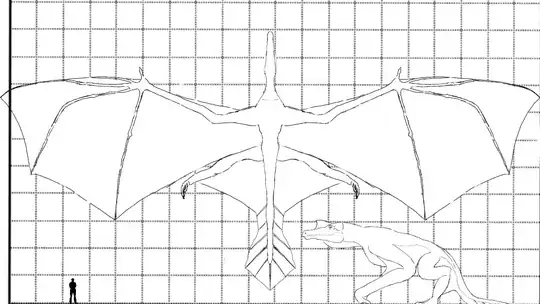For starters, allow me to define more carefully what I am asking. For now I am not worried about any of the following, as if this question is answered they will be covered in later questions:
- Bones breaking, tissues tearing etc. caused by the dragons large size, and organ systems required to support this creature. Both covered Here
- Metabolic requirements.
- How such a creature evolved or the plausibility thereof.
What I am asking is if I have made any mistakes or am missing any factors as to the mechanical ability of this dragon to fly.
I figured that whether or not my dragon could get off the ground, this question and subsequent answers might supply some basis to work off of for others who come to this site to ask about large flying creatures.
Warning - Math Ahead - Warning - Product of Someone with too much Free Time
I started with a sketch of the Dragon (Updated with Structure on tail to add some stability)

Using this Drawing I treated the body as a series of ellipsoids to calculate the volume. From there I ran numbers to find an appropriate wingspan etc. and edited the images to match.
The Dragon is designed with a head modeled loosely after a false gharial, wings and a chest modeled after those of a bat for flight, and a toads legs+a kangaroos tail to aid in liftoff.
Height: 6.5 meters
Length: 19 meters
Volume: 11.9 cubic meters
Average Density: 0.614 g/cm^3*
Weight: 7310 kilograms
Wingspan: 38 meters
Wing area: 304 square meters
Wing loading: 23 kg/m^2
Wings+Legs+Tail muscle cross-section: 43,000 cm^2
Muscle strength*** newtons/cm^2: 35 n/cm^2
Wings+Legs+Tail muscle strength: 1,474,900 watts
Liftoff time: 1 second
Height leaped in Liftoff**: 20.6 meters
Wing muscle cross-section: 21,600 cm^2
Wing muscle strength: 756,000 watts
Flap time: 2 seconds
Flap acceleration**: 21 meters a second
Coefficient of lift****: =<3.9
Coefficient of drag****: =>0.12
From nasa.gov
L = (1/2) d v2 s CL
L = Lift, which must equal the airplane's weight in pounds
d = density of the air. This will change due to altitude. These values can be >found in a I.C.A.O. Standard Atmosphere Table.
v = velocity of an aircraft expressed in feet per second
s = the wing area of an aircraft in square feet
CL = Coefficient of lift , which is determined by the type of airfoil and angle >of attack.
(I'll be using metric) Density of air at 3km above sea level and -4.5c = 0.9093 kg/cm^3
0.5 x 0.9093 x 10^2 x 304 x 0.6 = 8292.816 kg of lift, more than enough to get this guy off of the ground.
Drag = Cd (d v^2)/2 x reference area
The density of air at sea level and 20c = 1.225 kg/m^3. The reference area I calculate is (1.5 x 2)m^2 for the face and torso + (36 x 0.4)m^2 for the wings, or 17.4 m^2.
0.2 x (1.225 x 10^2)/2 x 17.4 = 213.15 newtons of drag, though I am not sure how to calculate the effect of this on the dragon.
*Density of bird lowered further by certain adaptations which will be discussed in another question.
**Found using a simple work-over-time equation.
***There is no difference in strength between fast and slow twitch muscle fibers, only in contraction speed and endurance. Paper which shows this.
****Actual Coefficients of bats, if there is some reason these would not be close enough, please let me know.
I was surprised after looking at these numbers that I wasn't actually seeing anything that as far as I could tell stopped the dragon from flying. But this is my first time doing any of the math involved, and even if I got all of it right I could be missing something, so I thought I'd ask some of the smart folks over here at Stack-Exchange and see what they told me.
Assuming that this creature runs and then leaps, using arms then legs+tail, to liftoff, followed by a few flaps of its wings, could it get air-born as my numbers imply? From there could it maintain flight?